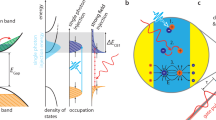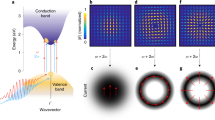Abstract
The time it takes to switch on and off electric current determines the rate at which signals can be processed and sampled in modern information technology1,2,3,4. Field-effect transistors1,2,3,5,6 are able to control currents at frequencies of the order of or higher than 100 gigahertz, but electric interconnects may hamper progress towards reaching the terahertz (1012 hertz) range. All-optical injection of currents through interfering photoexcitation pathways7,8,9,10 or photoconductive switching of terahertz transients11,12,13,14,15,16 has made it possible to control electric current on a subpicosecond timescale in semiconductors. Insulators have been deemed unsuitable for both methods, because of the need for either ultraviolet light or strong fields, which induce slow damage or ultrafast breakdown17,18,19,20, respectively. Here we report the feasibility of electric signal manipulation in a dielectric. A few-cycle optical waveform reversibly increases—free from breakdown—the a.c. conductivity of amorphous silicon dioxide (fused silica) by more than 18 orders of magnitude within 1 femtosecond, allowing electric currents to be driven, directed and switched by the instantaneous light field. Our work opens the way to extending electronic signal processing and high-speed metrology into the petahertz (1015 hertz) domain.
This is a preview of subscription content, access via your institution
Access options
Subscribe to this journal
Receive 51 print issues and online access
$199.00 per year
only $3.90 per issue
Buy this article
- Purchase on Springer Link
- Instant access to full article PDF
Prices may be subject to local taxes which are calculated during checkout



Similar content being viewed by others
References
Kahng, D. Electric field controlled semiconductor device. US patent 3,102,230. (1963)
Taur, Y. & Ning, T. H. Fundamentals of modern VLSI devices (Cambridge Univ. Press, 1998)
Liou, J. J. & Schwierz, F. Modern Microwave Transistors: Theory, Design and Performance (Wiley-Interscience, 2003)
Caulfield, H. J. & Dolev, S. Why future supercomputing requires optics. Nature Photon. 4, 261–263 (2010)
Schwierz, F. & Liou, J. J. RF transistors: recent developments and roadmap toward terahertz applications. Solid-State Electron. 51, 1079–1091 (2007)
. et al. Low noise amplification at 0.67 THz using 30 nm InP HEMTs. IEEE Microw. Wirel. Compon. Lett. 21, 368–370 (2011)
Kurizki, G., Shapiro, M. & Brumer, P. Phase-coherent control of photocurrent directionality in semiconductors. Phys. Rev. B 39, 3435–3437 (1989)
Atanasov, R., Hache, A., Hughes, J. L. P., van Driel, H. M. & Sipe, J. E. Coherent control of photocurrent generation in bulk semiconductors. Phys. Rev. Lett. 76, 1703–1706 (1996)
Prechtel, L. et al. Time-resolved picosecond photocurrents in contacted carbon nanotubes. Nano Lett. 11, 269–272 (2011)
Franco, I., Shapiro, M. & Brumer, P. Robust ultrafast currents in molecular wires through stark shifts. Phys. Rev. Lett. 99, 126802 (2007)
Valley, G. C. Photonic analog-to-digital converters. Opt. Express 15, 1955–1982 (2007)
Nagatsuma, T. Photonic measurement technologies for high-speed electronics. Meas. Sci. Technol. 13, 1655–1663 (2002)
Auston, D. H. Picosecond optoelectronic switching and gating in silicon. Appl. Phys. Lett. 26, 101–103 (1975)
Auston, D. H. Ultrafast optoelectronics.. Top. Appl.Phys. 60, 183–233 (1988)
Shimosato, H., Ashida, M., Itoh, T., Saito, S. & Sakai, K. in Ultrafast Optics V (eds Watanabe, S. & Midorikawa, K.) 317–323 (Springer Ser. Opt. 132, Springer, 2007)
Katzenellenbogen, N. & Grischkowsky, D. Efficient generation of 380 fs pulses of THz radiation by ultrafast laser-pulse excitation of a biased metal-semiconductor interface. Appl. Phys. Lett. 58, 222–224 (1991)
Zener, C. A theory of the electrical breakdown of solid dielectrics. Proc. R. Soc. Lond. A 145, 523–529 (1934)
Rethfeld, B. Free-electron generation in laser-irradiated dielectrics. Phys. Rev. B 73, 035101 (2006)
Jones, S. C., Braunlich, P., Casper, R. T., Shen, X. A. & Kelly, P. Recent progress on laser-induced modifications and intrinsic bulk damage of wide-gap optical-materials. Opt. Eng. 28, 1039–1068 (1989)
Lenzner, M. et al. Femtosecond optical breakdown in dielectrics. Phys. Rev. Lett. 80, 4076–4079 (1998)
Schwierz, F., Wong, H. & Liou, J. J. Nanometer CMOS (Pan Stanford, 2010)
Koslowski, T., Kob, W. & Vollmayr, K. Numerical study of the electronic structure of amorphous silica. Phys. Rev. B 56, 9469–9476 (1997)
Xu, L. et al. Route to phase control of ultrashort light pulses. Opt. Lett. 21, 2008–2010 (1996)
Kienberger, R. et al. Atomic transient recorder. Nature 427, 817–821 (2004)
Wannier, G. H. Wave functions and effective Hamiltonian for Bloch electrons in an electric field. Phys. Rev. 117, 432–439 (1960)
Bleuse, J., Bastard, G. & Voisin, P. Electric-field-induced localization and oscillatory electro-optical properties of semiconductor superlattices. Phys. Rev. Lett. 60, 220–223 (1988)
Mendez, E. E., Agulló-Rueda, F. & Hong, J. M. Stark localization in GaAs-GaAlAs superlattices under an electric field. Phys. Rev. Lett. 60, 2426–2429 (1988)
Bar-Joseph, I. et al. Room-temperature electroabsorption and switching in a GaAs/AlGaAs superlattice. Appl. Phys. Lett. 55, 340–342 (1989)
Durach, M., Rusina, A., Kling, M. F. & Stockman, M. I. Metallization of nanofilms in strong adiabatic electric fields. Phys. Rev. Lett. 105, 086803 (2010)
Durach, M., Rusina, A., Kling, M. F. & Stockman, M. I. Predicted ultrafast dynamic metallization of dielectric nanofilms by strong single-cycle optical fields. Phys. Rev. Lett. 107, 086602 (2011)
Schultze, M. et al. Controlling dielectrics with the electric field of light. Nature doi:10.1038/nature11720 (this issue).
Acknowledgements
We thank P. Altpeter and Y. Deng for technical support and discussions, and we thank the Munich-Centre for Advanced Photonics for financial support. A.S. acknowledges the Alexander von Humboldt Foundation and the Swiss National Science Foundation. N.K. acknowledges the Alexander von Humboldt Foundation. The work of M.I.S. and V.A. was supported by the Chemical Sciences, Biosciences and Geosciences Division (grant no. DEFG02-01ER15213) and by the Materials Sciences and Engineering Division (grant no. DE-FG02-11ER46789) of the Office of the Basic Energy Sciences, Office of Science, US Department of Energy. R.K. acknowledges an ERC Starting Grant.
Author information
Authors and Affiliations
Contributions
A.S., R.K., R.E. and F.K. designed and supervised the experiments. A.S., T.P.-C., D.G., S.M., J.R. and J.V.B. participated in sample design and fabrication. A.S., T.P.-C., N.K., D.G., S.M., M.S. and S.H. performed the measurements. A.S., N.K., V.A., M.K., V.S.Y. and M.I.S. took part in the theoretical modelling. A.S., T.P.-C., N.K., R.K., R.E., V.S.Y. and F.K. analysed and interpreted the experimental data. All authors discussed the results and contributed to the final manuscript.
Corresponding authors
Ethics declarations
Competing interests
The authors declare no competing financial interests.
Supplementary information
Supplementary Information
This file contains Supplementary Text and Data 1-4, Supplementary Figures 1-10 and additional references. (PDF 1394 kb)
Rights and permissions
About this article
Cite this article
Schiffrin, A., Paasch-Colberg, T., Karpowicz, N. et al. Optical-field-induced current in dielectrics. Nature 493, 70–74 (2013). https://doi.org/10.1038/nature11567
Received:
Accepted:
Published:
Issue Date:
DOI: https://doi.org/10.1038/nature11567
This article is cited by
-
Sub-cycle multidimensional spectroscopy of strongly correlated materials
Nature Photonics (2024)
-
Light-driven nanoscale vectorial currents
Nature (2024)
-
Ultrafast, nanoscale control of electrical currents using light
Nature (2024)
-
Attosecond field emission
Nature (2023)
-
Lightwave electronics in condensed matter
Nature Reviews Materials (2023)
Comments
By submitting a comment you agree to abide by our Terms and Community Guidelines. If you find something abusive or that does not comply with our terms or guidelines please flag it as inappropriate.



